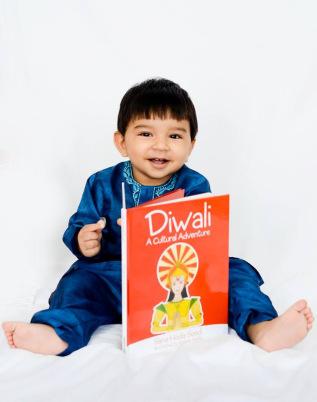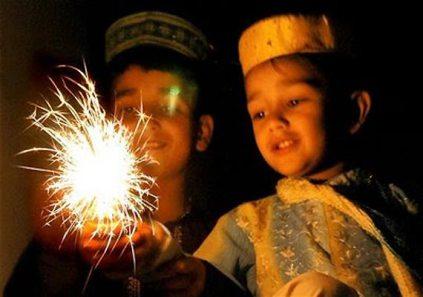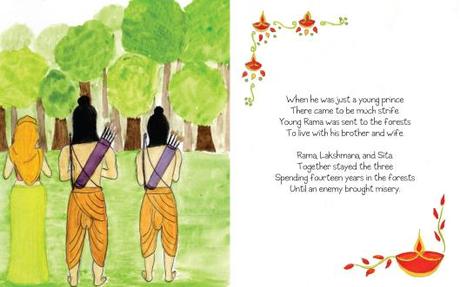
Baby not included.
Readers, I just spent my very first Diwali in India. In fact, it was my first Diwali in general. The joy of holding sparklers and throwing firecrackers, lighting the house with tons of candles, increasing my chances of diabetes with sweets, and playing taaash made me feel like a child again – a child who was seeing the joys of the festival for the first time. This type of joy is precisely what this new children’s book, Diwali: A Cultural Experience by Sana Hoda Sood, captures. For today’s special Diwali post, I introduce you to Sana herself along with her motivations for writing the book. Sana has just published the book with her mother, Rubina Hoda, who is the illustrator and is currently living in Istanbul, Turkey. Sana is now touring and promoting the book, so I am very lucky that in between the hustle and bustle and crazy time difference between DC and Delhi, I had the time to chat with her.
Sana was born in Gorakhpur, Uttar Pradesh, India, but then spent the first few years of her life in Assam and Meghalaya. She was 10 years old when her family decided to move to the US, but those years in India always remained with her. For Sana, Diwali and Eid were her favorite holidays. Sana and her family would head over to their friends’ homes, where her mother would sing bhajans (Hindu devotional songs) at Diwali pujas.
Despite Sana’s family being Muslim, it was understood that her mother would be the one singing the bhajans since she had the voice of an angel. All of the kids would be jittery throughout, impatiently waiting for night to fall so they could rush outside and pilfer through the fireworks table set out for them. As Sana says playfully, “I always had a plan of action in place, and immediately darted purposefully for the charkhay - the sparking, spinning lights.” Sana is not devoid of a deeper understanding of Diwali, but one cannot blame anyone for still being excited about the three things which excite any child during Diwali: new clothes, mouthwatering food and fireworks.

Courtesy of India TV News
Of course, I had to ask Sana about her love story with her husband, Nitin. Also, let’s be real – it is not everyday you hear of a successful, not to mention, drama-free, marriage between a UP Muslim woman and a Punjabi Hindu man.
Nitin and Sana met in DC, and immediately hit it off. They had the same sense of humor, and knew that kadhi-chawal was the key to happiness. Plus, he was actually taller than her – which was a deal sweetener for Sana. Yet, the story was simply happily ever after. Who would have thought? With both of their parents’ blessings, they decided on a Tuesday morning to faux-lope (elope, but with parental consent). They booked their flights, and two days later, were sitting in Maui, getting married on a beach at sunset with a justice of the peace and photographer as their witnesses. Both sets of parents have been very supportive of their decision. No Bollywood running scenes, no blood, no mothers screaming “Nahiiinnn” (Nooooo).
I then could not help but ask Sana the question, however, of what her response is to people who claim that people of two faiths cannot ever give their children “structure” or an “identity”. I was very pleased by the confidence in Sana’s response. She admitted that for her son Aarish, it only remains to be seen since he is only a year and a half old. However, her main focus at this point is that Aarish’s identity will be defined by his virtues — kindness, generosity and intelligence — traits that are extolled by both Islam and Hinduism. Let’s just conclude that for Nitin and Sana, faith has not been an issue.

In singing’s Nitin’s praises about his great amounts of support for Sana’s decision to take a break from her career and write, we were brought back to the actual book. For Aarish’s first Diwali, Sana knew there were a lot of options out there already, but none that captured the essence of Diwali in a way that would tell her son how the festival came to be, while at the same time, teach him what we can learn from it about being truthful, courageous people. Diwali isn’t about just the one day. It’s also about carrying those morals with us throughout our lives — morals that are not bound to any one religion, but to humanity as a whole.
There is a great line in her book that captures this:
There is a great line in her book that captures this:
“Diwali means fun and feasting/ but also so much more/ we remember that courage and kindness/ are what can make us soar. The strength and virtues of Rama/ they teach us all the ways/ to live with dharma and honor/ in all of our nights and days.”
Essentially, Sana’s book is an introduction to Diwali – it’s not a lengthy, heavily detailed recounting of the Ramayana. As such, the tenets of Hinduism and the origins of Diwali that are depicted in the book, are ones she was very familiar with, as an Indian who has celebrated Diwali for the past 30 years. It tells the story of Ram’s exile, life in the forests, his battle with Ravana to save Sita, and his eventual return to the kingdom as a bringer of joy and hope. The book then shifts to present day, how we celebrate Diwali today with our families, and the lessons we can learn from it to be honorable people. Diwali is the quintessential tale of good defeating evil, but the drama, characters and moral values really elevate the story to a timeless one — one that would appeal to Western and Indian audiences alike.

Finally, who can talk about a children’s book without the illustrations (and more grown-up books could use them). As mentioned, Sana’s mother, Rubina did the illustrations. She is a talented artist, and has painted each of the pictures in this book in gorgeous watercolors. From Istanbul, Rubina Aunty would Skype everyday with Sana about the progress of the writing and what their vision was for the book. The next day, she would come back online with these beautiful, bright paintings that breathed life and energy into the book.
As for Sana’s Diwali plans, with toddler in their midst, there will not be candles around the house. There will certainly be tons of dressing up, gorging on sweets, spending the day with family and friends, and of course, ending the day with reading “Diwali: A Cultural Adventure” to Aarish at his bedtime!

